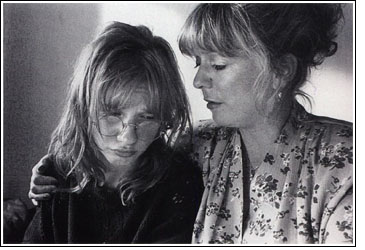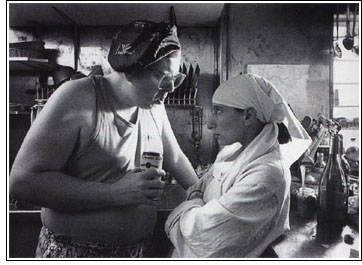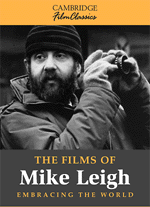|
 The
decorations in the Regret Rien present a parable about the difference
between superficial and deep meaning-making–in life and art. Like Salvador
Dali or Alfred Hitchcock (or the critic or viewer who gratefully decodes
the meanings they offer), Aubrey thinks that you create significance simply
by putting something in a frame and spotlighting it. Hitchcock tacks a
few stuffed birds on the walls of Norman Bates' office and "morbidity"
appears; Aubrey hangs up a bird cage to indicate "the Sparrow,"
a cat to indicate "the street," a gas mask to indicate "the
war," an accordion to indicate "the music of Paree" and
he thinks he's created those meanings. It's the semantic equivalent of
a heat-and-eat meal: instant, effortless, and ultimately insubstantial.
It takes no time or commitment on the part of the artist to create, and
no energy or involvement on the part of the viewer to consume (which is
why it results in no growth or nourishment). The
decorations in the Regret Rien present a parable about the difference
between superficial and deep meaning-making–in life and art. Like Salvador
Dali or Alfred Hitchcock (or the critic or viewer who gratefully decodes
the meanings they offer), Aubrey thinks that you create significance simply
by putting something in a frame and spotlighting it. Hitchcock tacks a
few stuffed birds on the walls of Norman Bates' office and "morbidity"
appears; Aubrey hangs up a bird cage to indicate "the Sparrow,"
a cat to indicate "the street," a gas mask to indicate "the
war," an accordion to indicate "the music of Paree" and
he thinks he's created those meanings. It's the semantic equivalent of
a heat-and-eat meal: instant, effortless, and ultimately insubstantial.
It takes no time or commitment on the part of the artist to create, and
no energy or involvement on the part of the viewer to consume (which is
why it results in no growth or nourishment).
Aubrey has not learned
the lesson the film he is in teaches–that meaning (the meaning
of a life, a family, a place, a relationship with another human
being) can only be created with time, effort, care, sensitivity,
and beat-by-beat responsiveness. Meaning must be made, it
cannot simply be indicated (which is why the meanings in
Leigh's work are so different from and take so much more than effort
to comprehend than the metaphors and symbols in Hitchcock, Lynch,
the Coens, Stone, and similar artists). As all of Leigh's work is
devoted to demonstrating, meaning cannot merely be willed; it must
be worked into being. It cannot simply be declared; it must be earned.
It isn't made abstractly and quickly, but slowly and arduously.
The entire stylistic
enterprise of Leigh's work contrasts with that of American film
in this regard. While the transcendental or visionary truth of Sternberg,
Welles, or Hitchcock is instantaneous (like Aubrey's cat and accordion
set decorations, you simply "see" the meaning and it exists),
the practical, social truths of Leigh's works are a product of work
and duration. They take time and effort to make in the first place
and they keep changing from second to second. They take time and
work for a viewer to apprehend and time to keep up with. Knowledge
is slow and arduous. It's not something you suddenly "get"
(as in visionary film), but something that is gradually and progressively
achieved.
Like Aubrey's notion
of set decoration, the insistently metaphoric methods of most American
films elevate the truth of ideas over the truth of experiences.
Meanings are rendered in a kind of intellectual shorthand in which
"this means that" in a strictly intellectual way. A sled
means a lost childhood; a cavernous livingroom means loneliness;
ominous music and shadowy lighting mean spiritual emptiness and
nostalgia. Leigh is committed to a more spatially involved and temporally
extended sense of truth. Truth is not the product of a viewer's
or a character's mental relation to a series of sounds and images
(the heart of the metaphoric-symbolic method), but is the result
of the viewer's and character's complex, gradual process of interacting
with a series of people and events extended across space and time.
Leigh' characters do not interact in term of glances, and his viewers
cannot take in his meanings at a glance. His meanings must be lived
through and lived into.
 Aubrey's
off-the-peg sense of selfhood and just-add-water understanding of meaning
seem all the shallower insofar as they are juxtaposed next to the complexities
of identity and involvement that Wendy and Andy display. The difference
is comically summed up in the semantic contrast between Aubrey's "Marry
me, Wendy. I love you" and their more challenging illustration of
what real love and marriage involve. What Wendy and Andy are (both as
characters in a movie and people living a life) is achieved gradually
and tentatively, in the time and space of interactions as complex as the
ones I have described. Their individual identities and relationship with
each other are not brought into existence instantly, effortlessly, and
unilaterally by means of a prop (a pineapple), a costume (a sports jacket),
or a pickup line ("You know, you look fantastic"), but are lived
through and worked into existence one beat at a time. Aubrey's
off-the-peg sense of selfhood and just-add-water understanding of meaning
seem all the shallower insofar as they are juxtaposed next to the complexities
of identity and involvement that Wendy and Andy display. The difference
is comically summed up in the semantic contrast between Aubrey's "Marry
me, Wendy. I love you" and their more challenging illustration of
what real love and marriage involve. What Wendy and Andy are (both as
characters in a movie and people living a life) is achieved gradually
and tentatively, in the time and space of interactions as complex as the
ones I have described. Their individual identities and relationship with
each other are not brought into existence instantly, effortlessly, and
unilaterally by means of a prop (a pineapple), a costume (a sports jacket),
or a pickup line ("You know, you look fantastic"), but are lived
through and worked into existence one beat at a time.
Wendy and Andy show themselves
capable of doing the same thing Leigh's style does: imaginatively
entering into and sympathizing with alien points of view (even ones
as odd as the lady with the stuffed dog and the ration stamps).
Aubrey is trapped in his own view of everything. As the comical
misunderstandings in his interactions with Wendy illustrate, he
doesn't really listen to, respond to, or understand any point of
view beyond his own (a point Leigh makes wittily by having Timothy
Spall insert a "delay" before most of his responses, as
if he were perpetually out of synch with the world).
There is no play in Aubrey's
understanding of himself or others. While Wendy, Andy, and Natalie's
relationship to each other and everyone they meet freely flows and
changes from moment to moment, holding many emotions and thoughts
in suspension, Aubrey is locked into static forms of selfhood and
formulaic ways of interacting. Like Peter, Sylvia's boss, Keith,
or Beverly, Aubrey reduces interactions with others to mechanical
"routines." Leigh comically summarizes the shallowness
of Aubrey's conception of conversation in terms of his singles'
bar approach to interaction, in which he apparently employs the
same pickup lines with every woman he meets: "You know you've
got beautiful hands, legs, hair, blah, blah, blah." As is always
the case in Leigh's work, since Aubrey is playing a role that is
inherently false, and playing it badly and mechanically, there is
no depth to his performance. In this world where surfaces are everything,
everything is on the surface....
–Excerpted from Ray
Carney, The Films of Mike Leigh: Embracing the World (London
and New York: Cambridge University Press, 2000).
 |
  |
Ray
Carney's The Films of Mike Leigh is quite simply the
best book of film criticism I have ever read.
Now I have to say
that I have never read any of Carney's other books (he has
also written books on Cassavetes, Frank Capra, and Carl Dreyer),
which, for all I know, might be even better. But as a friend
of mine put it, 'His writing blows everything else out there
away, even to the point of many times seeming like simply
in a class of his own...different in kind more than degree.'
And although I admit to not having read 'everything else out
there,' I feel the exact same way. Ray Carney's new book has
undeniably rocked my world.
Ray Carney's book
is to what usually passes for film criticism what Mike Leigh's
movies are to what, in Hollywood, usually passes for filmmaking:
a truly radical critique, a whole different animal, and a
solitary voice of sanity that has somehow miraculously managed
to make itself heard over the noise and hullabaloo of this
culture's present-day insanity. |
|
–Caveh
Zahedi, creator of A Little Stiff and I Don't Hate
Las
Vegas Anymore,
in a review in Filmmaker Magazine |
| |
  |
| |
Mike Leigh’s work is difficult to pin down. Echoing what Ray Carney says of Leigh’s more blinkered characters, examining these films becomes a lot murkier when you bring too many ideas and film-critical categories to bear. Although not without its strengths and serendipities, Garry Watson’s book suffers from intellectual larding while, like one of Leigh’s more far-sighted characters, Carney and Quart’s gets in amongst the rough-and-tumble....
The Carney and Quart book was the first critical study of Leigh’s work and every subsequent book on Leigh must negotiate its rigor and insight. I have yet to read a book that better approximates my experience of watching Leigh’s films.My one regret is that, apart from the important BBC plays Nuts in May and Abigail’s Party (1977), I have yet to see many of the early works wherein Carney locates the wellspring of Leigh’s improvisatory power and vision.
Animating this study is a distinction between two types
of Leigh characters that resonates culturally, politically and
spiritually across his work. For Carney, there are those like
Rupert and Laetitia Boothe-Braine in High Hopes (1988),
Nicola in Life Is Sweet (1990), and Sebastian in Naked (1993)
who, mired in a mental image of themselves, pigeon-hole
others in prejudices, effectively foreclosing on generous and
responsive solidarity. Then there are those like Cyril and
Shirley in High Hopes, Wendy in Life Is Sweet, and Louise in Naked who have all the foibles, strengths, and self-doubts of
their humanity, and are open to the flows of human interaction.
Alison Steadman’s giggly and affectionate Wendy still
epitomizes the principle of social cohesion in Leigh. It is perhaps
unsurprising that Steadman and Leigh were married,
while the positive response to the density of experience recalls
the thick descriptive methodology through which a Leigh
film is arrived at. Evoking the Dickensian and Lawrentian
views of human sensibility (as Watson points out), Leigh feels
that the individual mindset has consequences for the wider
culture, and by this light the generous impulse in Wendy and
other Leigh characters has been eroded by consumerism and
social mobility in postwar Britain. Not as overtly political as
Ken Loach, Leigh has nevertheless chronicled the domestic
consequences of the decline of the social consensus imagined
by writers from Dickens to George Orwell.
One of the most unexpected aspects of Carney and Quart’s book is the way it puts mainstream American cinema in perspective by comparing it with Leigh’s cinema.With his focus on characters as mannered and tic-ridden “outsides” (as opposed to Hollywood’s granting us access to Forrest Gump’s inner kindness despite the goofy exterior), Leigh charts that elusive quality, the “ordinary” moment—the everyday drama of interaction they never show in Hollywood because it occurs between the heroics.
In doing so, Carney shows, Leigh pulls apart the Enlightenment model of agency and volition on which most American movies depend. Recalling classes he has taught—he is Director of Film Studies at Boston University—Carney describes how Americans are often perplexed by a cinema in which nothing seems to happen. But Leigh’s drama of transformation is rooted in the layered rehearsal of interpersonal dynamics observed with the patience of a European Ozu. Whilst British Leigh commentators have been preoccupied with the writer-director’s purchase on the sociological landscape, Carney convinces us that Leigh and Ozu share a feeling for the interplay of performance and mise-en-scène which moves beyond David Bordwell’s pioneering Ozu dichotomy between modernism and tradition. Leigh’s conception of experience (unlike that of Hollywood) is durational rather than deadlined, heterogeneous rather than hurried. Carney’s examination of space and time in Leigh reveals, as Bordwell has done elsewhere, that the mainstream model of experience conceals as much as it reveals.... |
| |
–Richard Armstrong, a review of Gary Watson, The Cinema of Mike Leigh and Ray Carney and Leonard Quart, The Films of Mike Leigh: Embracing the World, published in Film Quarterly, Dec 2005, Vol. 59, No. 2, pp. 62-63 |
| |
  |
| |
No other study sheds such a revealing light on Leigh's background, his influences, his emotional groundings, and, of course, his unique cinematic sensibility....[Carney's The Films of Mike Leigh is a] powerful and multifaceted analysis which welcomes, like Leigh's work, the vibrant eye and the uncalcified consciousness.
|
| |
-- Andrew Hamlin, in a review of Ray Carney's The Films of Mike Leigh: Embracing the World, published in MovieMaker Magazine. |
| To learn
how to obtain this book, click
here |
|










